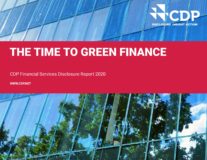
Bron
CDP
The GHG emissions associated with financial institutions’ investing, lending and underwriting activities are on average over 700 times higher than their direct emissions, according to a first-of-its-kind report by non-profit CDP, which runs the global environmental disclosure system. TheTime to Green Finance, released today, shows that almost all climate-related impacts and risks of global financial institutions come from financing the wider economy. However, just 25% of the 332 financial institutions disclosing in 2020 through CDP’s first financial services climate change questionnaire reported portfolio emissions.
The 84 organizations disclosing their portfolio impact include AXA Group, BNP Paribas, BNY Mellon, HSBC Holdings plc, Legal and General and Nomura Holdings and hold US$27 trillion of assets. Over half of these 84 organizations included less than 50% of their portfolios in their financed emissions reporting.
Given the growing momentum of financial institutions announcing net zero targets, CDP’s report shows that the sector must take further action to align portfolios with a net zero carbon economy. Under half of banks (45%), asset owners (48%) and asset managers (46%) report taking action to align investments with a well below 2-degree Celsius goal, and just 27% of insurers are doing so for underwriting portfolios. Examples of such actions include setting science-based emissions reduction targets, reducing portfolio emissions through engagement with companies and investing in renewable energy.
In addition to underreporting portfolio emissions, financial institutions are also underestimating climate-related risks. Financial institutions more commonly identify direct operational climate-related risks, such as physical damage to their operations (41%), but the vast majority are not yet reporting credit risks (65%), such as borrowers’ default on loan repayments and market risks (74%), such as stranded assets and financial asset price devaluation.
Yet these credit and market risks have a much higher reported potential financial impact (over US$1 trillion combined versus just US$34 billion for the operational risks reported). This shows that many financial institutions do not yet report and/or manage their most significant climate-related risks – those associated with financing.
Conversely, financial institutions appear to be focused on low-carbon transition opportunities. 76% identify opportunities in sustainable finance products like sustainability-linked loans, green and transition bonds, sustainable investment funds and insurance solutions – worth up to US$2.9 trillion.
Most financial institutions reported some board-level oversight of climate-related issues, however this is largely focused on their direct operations rather than financing activities. This trend is most notable in the insurance industry where board-level oversight covers the impact of underwriting on climate change at only 31% of insurers.
Financial institutions must engage with portfolios and insist companies are prepared for the net zero transition; beginning with the measurement and disclosure of environmental impact. Less than half, 46%, of asset owners and 50% of asset managers reported engagement, most commonly as active owners. Collective engagement initiatives such as CDP’s Non-Disclosure Campaign and Science-Based Targets Campaign offer investors a step into active ownership.
Emily Kreps, Global Director of Capital Markets at CDP, said: “The financial services sector is critical to achieving a net zero carbon future. The real economy transition will require a massive amount of capital directed at decarbonizing the economy and enhancing resilience, which only the finance sector can facilitate and provide. As regulators move towards mandatory disclosure – CDP, with its 20+ years of providing comparable and TCFD-aligned environmental disclosure data to the capital markets, is ideally positioned to assess the global finance sector’s readiness to respond.
For financial institutions that do not currently measure their financed emissions the message from this flagship report is clear – they must start doing so, now, to understand their overall climate-impact and the risks they face. We urge all financial institutions to commit to de-carbonize their portfolios by setting science-based emissions reduction targets, aligning all activity with the Paris Agreement and disclosing the impact of their financing activities.”
TheTime to Green Finance report names some best practice examples from among the disclosing financial institutions, including Allianz SE for governance of climate-related issues, and ABN AMRO for measurement and disclosure of portfolio emissions.
CDP’s The Time to Green Finance report analyses structured, comparable self-reported environmental data from 332 financial institutions representing US$109 trillion of assets. The institutions disclosed through CDP’s first 2020 climate change questionnaire for the financial services sector.



